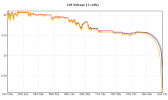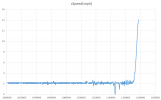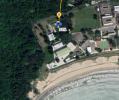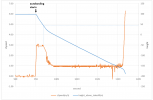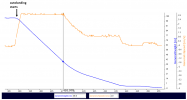Hi there,
massive rookie mistakes on my side and feeling super stupid, but can't make it undone. What happened ?
I went flying yesterday in strong winds which was the main/initial mistake. After take off (I had picked a higher spot to avoid losing connection with the surrounding mountains), I quickly got the "Strong Winds" Warning. As I had the drone in sight, I switched to sports mode and turned around, so all good.
After flying around for awhile (back in N-Mode) with changing wind conditions (but on the upwind side), I made the second mistake to fly downwind. That's when things went south.
At around 11:15, the video transmission and signal got weaker (couldn't see anything and didn't switch to map mode...another mistake) and I was advised to "fly cautiously", so I started to turn around, but quickly got the "Strong wind signal" again at 11:20 (incl the confusing/misleading notification that RTH is not possible in this case, and I needed to fly manually).
At 11:32, I lost connection with the drone for quite a long time (35 secs) which put me into panic mode. Because I assumed (per above misleading notification), that RTH wouldn't work in these strong winds, so I had to maintain connection with the drone to be able to manually steer (and continue to receive tracking/gps info), so I raced down the hill to my car to go after it as it was moving away from me. This was the 3rd mistake as it meant that I wasn't able to use that precious time to navigate the drone manually and land it in same safe spot. but yeah, panic mode.....
By now, I have learnt that RTH will be activated if the connection gets lost, no matter what. So while I was in my car, the drone switched into "Go home" mode and started to ascend (fourth mistake as I had my RTH altitude at 100m which of course was way too high for the terrain and wind). So over the next couple of minutes, the drone was climbing up to 400m above sea level (takeoff alt: 300m + 100m RTH alt) while drifting downwind and depleting the batteries rapidly. During that time, the wind speed was around 16 m/s and the drone was flying straight into it but not making any progress but rather getting pushed back. I read here that in strong winds, the drone can tilt with 35 degrees and thereby achieve Sport mode speeds (19 m/s), but not sure whether that's possible in an RTH situation.
At around 16min, the battery level dropped to 10% and it changed to AutoLanding mode. This is the part that I don't get. Instead of going straight down aggressively (which would have resulted in lower winds), the horizontal movement was still stronger than the vertical one which meant that it stayed within the wind channel. Over the next 3:40min (until the last recorded position), it travelled for another 1.5km while only losing 280m altitude. Of course, at that point, I should have focused on getting it down safely, but I still had these connection problems.
My only hope now is to make a prediction about the trajectory of the fall. At the last recorded point, the altitude was 110m above sea level (and around 150m away from the ocean). I would have thought that with lower winds (closer to the ground) and zero rotors, that it would drop now more drastically, but that's just a guess of course.
EDIT: After syncing my flight logs with AirData, I downloaded the txt file from there and uploaded it to PhantomHelp, but it doesn't show any data even though the download finished.
thanks in advance, Nick
massive rookie mistakes on my side and feeling super stupid, but can't make it undone. What happened ?
I went flying yesterday in strong winds which was the main/initial mistake. After take off (I had picked a higher spot to avoid losing connection with the surrounding mountains), I quickly got the "Strong Winds" Warning. As I had the drone in sight, I switched to sports mode and turned around, so all good.
After flying around for awhile (back in N-Mode) with changing wind conditions (but on the upwind side), I made the second mistake to fly downwind. That's when things went south.
At around 11:15, the video transmission and signal got weaker (couldn't see anything and didn't switch to map mode...another mistake) and I was advised to "fly cautiously", so I started to turn around, but quickly got the "Strong wind signal" again at 11:20 (incl the confusing/misleading notification that RTH is not possible in this case, and I needed to fly manually).
At 11:32, I lost connection with the drone for quite a long time (35 secs) which put me into panic mode. Because I assumed (per above misleading notification), that RTH wouldn't work in these strong winds, so I had to maintain connection with the drone to be able to manually steer (and continue to receive tracking/gps info), so I raced down the hill to my car to go after it as it was moving away from me. This was the 3rd mistake as it meant that I wasn't able to use that precious time to navigate the drone manually and land it in same safe spot. but yeah, panic mode.....
By now, I have learnt that RTH will be activated if the connection gets lost, no matter what. So while I was in my car, the drone switched into "Go home" mode and started to ascend (fourth mistake as I had my RTH altitude at 100m which of course was way too high for the terrain and wind). So over the next couple of minutes, the drone was climbing up to 400m above sea level (takeoff alt: 300m + 100m RTH alt) while drifting downwind and depleting the batteries rapidly. During that time, the wind speed was around 16 m/s and the drone was flying straight into it but not making any progress but rather getting pushed back. I read here that in strong winds, the drone can tilt with 35 degrees and thereby achieve Sport mode speeds (19 m/s), but not sure whether that's possible in an RTH situation.
At around 16min, the battery level dropped to 10% and it changed to AutoLanding mode. This is the part that I don't get. Instead of going straight down aggressively (which would have resulted in lower winds), the horizontal movement was still stronger than the vertical one which meant that it stayed within the wind channel. Over the next 3:40min (until the last recorded position), it travelled for another 1.5km while only losing 280m altitude. Of course, at that point, I should have focused on getting it down safely, but I still had these connection problems.
My only hope now is to make a prediction about the trajectory of the fall. At the last recorded point, the altitude was 110m above sea level (and around 150m away from the ocean). I would have thought that with lower winds (closer to the ground) and zero rotors, that it would drop now more drastically, but that's just a guess of course.
EDIT: After syncing my flight logs with AirData, I downloaded the txt file from there and uploaded it to PhantomHelp, but it doesn't show any data even though the download finished.
thanks in advance, Nick
Attachments
Last edited:



